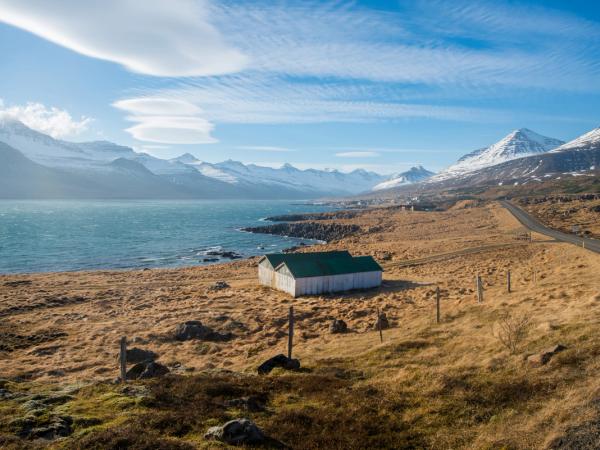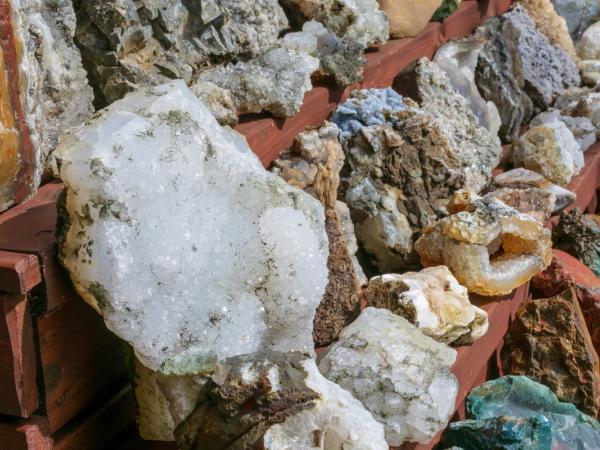
15 Great (And Not So Typical) Things to Do in Iceland in September
Want to see the real Iceland? September's your month. Fewer tourists, lower prices, and autumn colors paint the landscape. You'll catch early Northern Lights while roads stay open and temps remain mild.
From hidden hot springs to quiet beaches, here are 15 activities to make the most of your September trip to the Land of Fire & Ice.
1. Chase the Northern Lights in Hvalfjörður
September is the start of aurora season, and you don't need an expensive tour to see them. Head to Hvalfjörður fjord, an hour from Reykjavík, for a great viewing spot without crowds.
Drive to the western side near Grundartangi, where it's darker. Check Vedur.is before going – look for a KP index of 3 or higher. Plan to arrive after 10 PM when it's dark enough.
If the lights show up, they might reflect in the still water for a double display. Even if the aurora doesn't appear (they're never guaranteed), you'll see incredible stars above this quiet fjord.
Bring a blanket, hot drinks, and a proper camera if you'd like to take photos. Phones can catch faint lights, but a real camera with manual settings works much better.
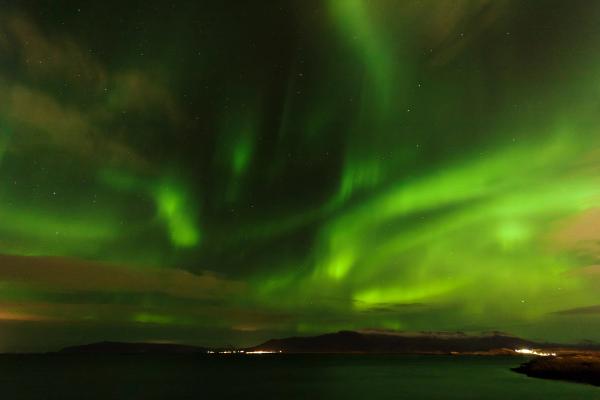
2. Hike to Svartifoss Waterfall
Svartifoss, in Skaftafell Nature Reserve (part of the Vatnajökull National Park), isn't the biggest waterfall in Iceland, but it might be the most striking. The black basalt columns around it look almost like they were built by hand, though they're completely natural. These strange formations actually inspired the design of Reykjavík's Hallgrímskirkja church.
The hike from Skaftafell visitor center takes about 1.5 hours round-trip and isn't too hard. You'll walk through pretty moorland and pass a couple of smaller waterfalls on the way. September brings the first fall colors – reds and golds that pop against the black rock.
Wear shoes with a good grip, as the path can become slippery when wet. Parts of the trail have boardwalks to protect the plants, so stick to the marked route.
Midday provides the best lighting for photos, but consider starting early to avoid tour buses, which typically arrive around 11 AM. The visitor center has helpful maps and sometimes offers ranger talks about the area.
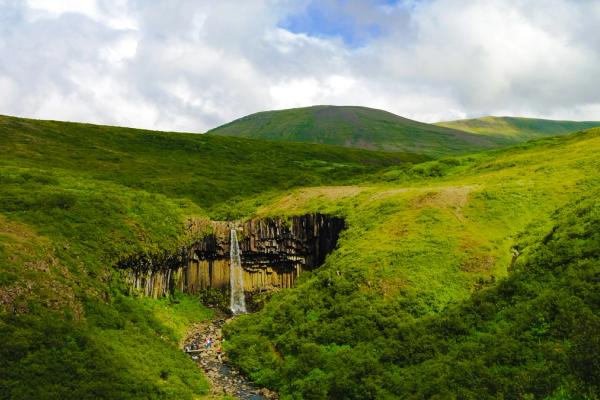
3. Soak in Seljavallalaug Hot Pool
Skip the Blue Lagoon crowds and head to Seljavallalaug instead. Built in 1923, it's Iceland's oldest swimming pool, tucked in a valley below Eyjafjallajökull volcano (the one that erupted in 2010).
A 15-minute hike from the parking area leads you along a small river. The walk is beautiful, with mountains on both sides. When you spot the pool – a simple concrete rectangle built against the mountainside – it feels like finding a secret.
The natural hot spring keeps the water around 30-35°C. It’s not the hottest, but it's perfect in September's cooler air. The pool is free, but don't expect luxury here. The changing room is just a basic concrete building, often muddy. Bring a towel, swimsuit, and flip-flops since the pool bottom gets slippery.
Don’t leave garbage or anything you bring behind. This pool is maintained by volunteers, so the more effort we make to keep it clean, the better. Try to visit on weekdays or mornings to avoid the locals who sometimes come on weekends.
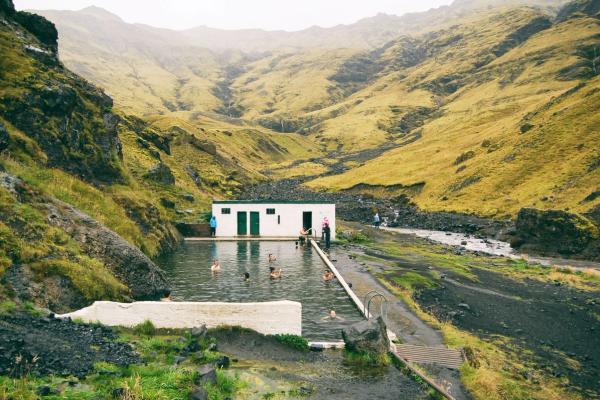
4. Whale Watching from Húsavík
If you want to see whales in Iceland (and you should), Húsavík is the place to go. This small and cozy fishing village in North Iceland has earned its nickname as the whale watching capital, and September offers great conditions before winter storms arrive.
The bay is rich in nutrients that attract minke whales, humpbacks, and sometimes orcas. They're feeding heavily before migrating south for winter, increasing the chances of seeing them. Most tours use fast boats with smaller groups (8-12 people), giving you a better experience than the big boats from Reykjavík.
Tours usually last three hours. Operators provide warm overalls, though you should dress warmly. They typically serve hot drinks onboard, too. Bring binoculars and a camera with decent zoom for breach shots if you have them.
After your tour, stop by the Whale Museum in town to learn more about what you saw. If you're chilly, head to GeoSea, a small hot pool with views over the same bay where you were just watching the whales.

5. Explore Hornstrandir Nature Reserve
For wilderness lovers, Hornstrandir in the remote Westfjords might be your trip highlight. This uninhabited peninsula has no roads, shops, or services – just raw nature. It's one of the few places in Europe where you can hike for days and barely see signs of humans.
You can only reach it by boat from Ísafjörður, and September is the last month before winter makes visits impossible. The trails stay open, and you might see the first snow on the highest peaks if you’re lucky.
What makes Hornstrandir special is its unique wildlife, particularly the Arctic foxes. Since the area has been protected for decades, these normally shy animals often approach hikers without fear. September is great for spotting them as they gather berries for winter.
For experienced hikers, try the trail to Hornvík, which takes 4-6 hours but rewards with views of Iceland's tallest sea cliffs. If that's too much for you, just stick to the several short trails you can do from where the boat leaves you,
You need to be self-sufficient here. Bring all food, a good tent, and warm layers as temperatures can drop to around 5°C. Book boat transport through companies like West Tours, but note that the weather can change schedules. This pristine wilderness is special. Leave no trace so others can enjoy it too.

6. Visit the Christmas Garden in Akureyri
Need a break from Iceland's dramatic landscapes? The Christmas Garden (Jólagarðurinn) near Akureyri is something completely different – quirky, uniquely Icelandic, and open year-round.
This fun spot introduces you to Iceland's unusual Christmas traditions, especially the 13 Yule Lads – mischievous characters who replace Santa in Icelandic folklore. You'll also learn about their ogre mother Grýla, and the Christmas Cat, who supposedly eats children who don't get new clothes for Christmas. (Yes, Icelandic Christmas is surprisingly dark!)
The garden feels cozy even in September. Look for handmade decorations while having hot chocolate and gingerbread in the café. Staff share stories about local customs, like how Icelandic kids put shoes on their windowsills for 13 nights to get small gifts from the Yule Lads.
Entry is free, though most visitors buy a unique ornament or two. The nearby spruce forest (rare in mostly treeless Iceland) offers a nice walk afterward. It's a low-key stop that shows you Icelandic culture beyond the typical tourist spots.
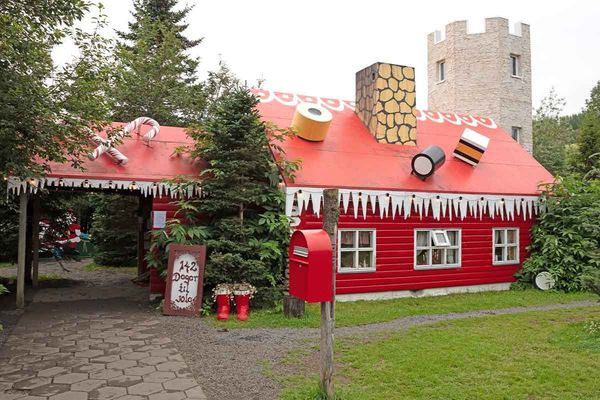
7. Climb Mount Laki at Laki Craters
Few places in Iceland mix geology and history like Laki Craters. This massive system of over 100 volcanic craters formed during a huge eruption in 1783 that killed a quarter of Iceland's population and affected weather worldwide.
September is ideal for visiting since the highland F-roads (F206/F207) are still open, but summer crowds are gone. You'll need a proper 4WD vehicle with high clearance – a regular rental car is not allowed.
The climb up Mount Laki takes 1-2 hours and isn't technically hard, though there's some loose gravel. From the top, you get an amazing view of the crater row stretching for 25 kilometers, with black lava fields, bright green moss, and distant glaciers creating a landscape that looks like another planet.
The nearest services are in Kirkjubæjarklaustur, about 50 km away, so fill your gas tank and bring food and water. The isolation is part of what makes this special – standing where such a world-changing event happened, with hardly anyone else around, connects you to Iceland's powerful geology.
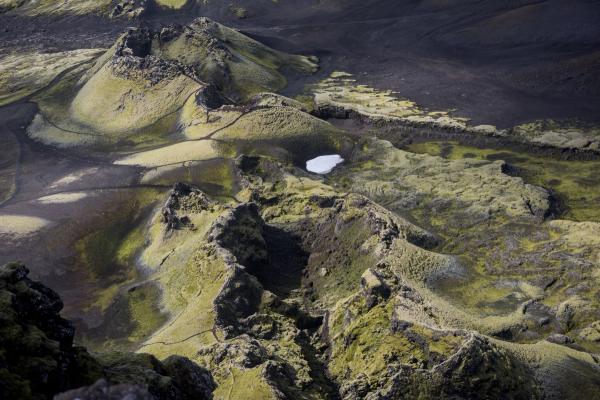
8. Zipline Near Vík
For an adrenaline rush with great views, try the zipline course near Vík on Iceland's south coast. Tours last 1.30-2 hours, where four ziplines ranging from 30-240 meters send you flying over river canyons and alongside waterfalls in the dramatic Grafargil canyon.
September's mild weather is great for outdoor activities without summer crowds. The experience starts with a short hike to the first platform, building excitement before your first ride. Between zips, guides share stories about local geology and history. Groups are usually small, which makes the experience more personal.
Wear closed-toe shoes and dress in layers for the breeze you'll create while zipping along. Book ahead as slots fill quickly even in September. At around 90$ per adult, it's not cheap, but the unique view of Iceland's landscape and its thrill make it worth considering if it fits your budget.
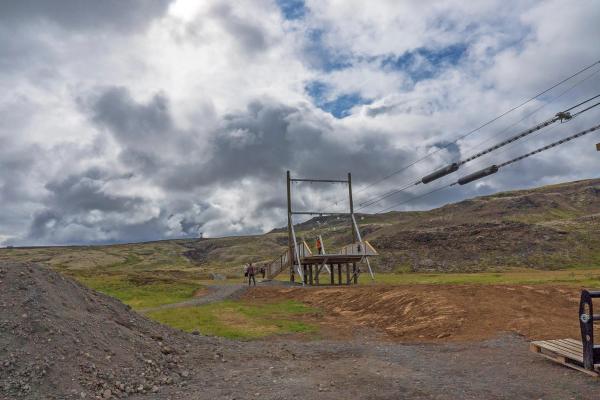
9. Tour a Microbrewery in Siglufjörður
Iceland has a surprising craft beer scene despite having banned beer until 1989 (yes, beer was illegal here for most of the 20th century). Segull67, a family-run microbrewery in the northern fishing village of Siglufjörður, offers a perfect taste of this growing culture.
The one-hour tour explains how beer is made and Iceland's weird history with alcohol. September ensures smaller groups and more chances to chat with the brewers. Tastings include creative flavors you won't find elsewhere, like seaweed-infused ales or smoky porters that capture Iceland's unique environment.
The brewery sits right by the harbor in this pretty village, once the herring capital of Iceland. After your tour, visit the excellent Herring Era Museum next door to understand how this tiny place was once central to Iceland's economy.
Book your tour ahead of time as spots are limited and can run out. It's a tasty way to connect with local culture beyond the usual tourist spots.
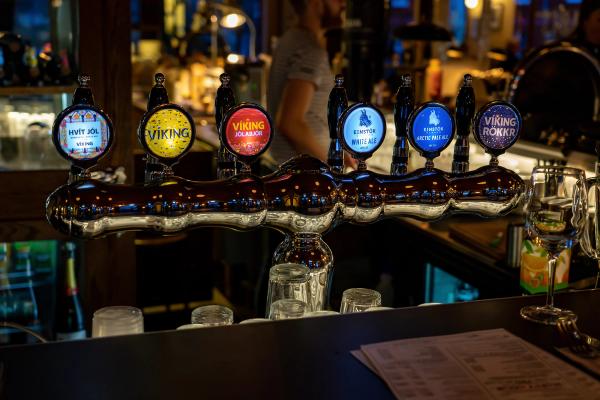
10. Discover Raudasandur Red Beach
Everyone knows about Iceland's black beaches, but hardly anyone visits the red-gold sands of Raudasandur in the Westfjords. This 10km beach glows orange, pink, and gold depending on the light – nothing like the black volcanic beaches elsewhere.
The color comes from crushed scallop shells, not volcanic rock. September brings clear weather that makes these colors pop. Keep an eye out for seals playing in the water or lounging on the sand. The beach sits under tall cliffs, and Látrabjarg bird cliffs (the westernmost point in Europe) are just a short drive away.
Getting here isn't easy – you'll drive a winding gravel road (Route 612) from Patreksfjörður, and a 4WD helps. Check tide times before you go, as high tide cuts off some areas. But the trip is worth it to see the colors and isolation that most visitors to Iceland miss completely.
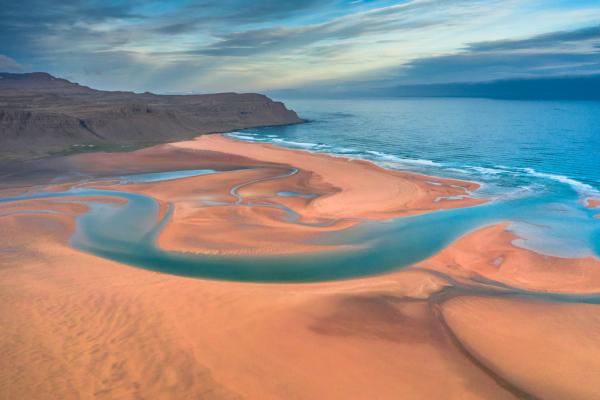
11. Tour the Icelandic Punk Museum in Reykjavík
For something totally different, check out the Icelandic Punk Museum in downtown Reykjavík. It's in an old underground public toilet. Yes, really – a toilet. This tiny place tells the story of how punk rock shook up Iceland's conservative culture in the 70s and 80s and helped build the creative scene that later gave us artists like Björk.
The space is packed with photos, records, and punk stuff, showing the raw energy of Iceland's punk scene. Put on headphones to hear tracks from bands like KUKL (Björk's punk band), seeing how Iceland's famous music scene has roots in this gritty movement.
You only need about 30 minutes here, perfect for a rainy afternoon. It's right on Bankastræti in the center of town, so you can easily pair it with shopping or coffee. Music fans will love seeing this hidden piece of Icelandic culture.
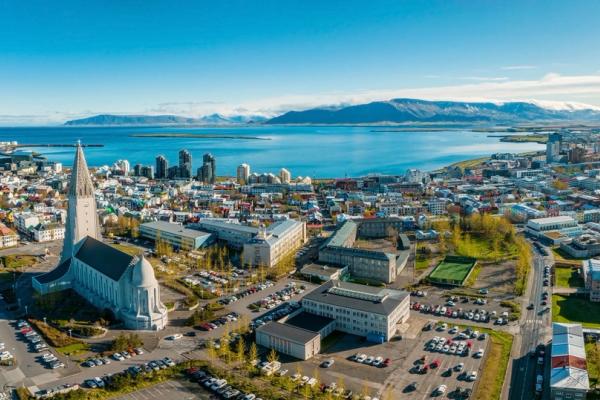
12. Hike to Glymur Waterfall
Want a great hike that doesn't eat up your whole day? Head to Glymur, Iceland's second-highest waterfall, at 198 meters (650 feet). It crashes down into a green canyon in Hvalfjörður, just an hour from Reykjavík, but is missed by most tourists rushing around the Golden Circle.
The 2-3 hour hike starts from the Botnsdalur parking lot. You'll cross a river – sometimes on a log bridge, sometimes by wading if the water's high. September can be muddy, so bring waterproof boots. The upper trail offers the best views but can be weather-beaten, so check the forecast first.
The cool part is how fast you go from an ordinary valley to a deep, narrow canyon with the waterfall visible from different angles. The canyon has plants you won't find in other parts of Iceland, if you're into that.
Many people do this hike and then stick around Hvalfjörður to hunt for Northern Lights later, since the area is good for both. Or just bring a picnic to enjoy at the grassy area by the trailhead before or after your hike.

13. Visit Petra's Stone Museum in Stöðvarfjörður
One of Iceland's most touching attractions isn't a waterfall or volcano, but a tribute to one woman's rock obsession. Petra's Stone Museum in tiny Stöðvarfjörður village shows off the collection of Petra Sveinsdóttir, who spent decades picking up pretty rocks from the surrounding fjords.
What started as a hobby turned her house and garden into a rock wonderland. September is quiet, giving you space to check out the agates, jaspers, and zeolites without crowds, with the peaceful fjord in the background.
Walk through garden paths where rocks are arranged just so, or go inside Petra's old house to see shelves full of polished stones. Staff often includes locals who knew Petra and share stories about her life and collecting.
After the museum, walk to the puffin colony at Hafnarnes (though most puffins leave by September) or drive to the pretty Seyðisfjörður valley nearby. The museum's relaxed vibe and personal story show you an Iceland beyond volcanoes and waterfalls. The entrance fee is 2000 ISK (15$) if you’re 14 years or older.
14. Hike to Huldujökull Glacier in Þakgil
If you’re a real adventurer who wants to ditch the tourist crowds, the hike to Huldujökull Glacier is for you. It's tough but worth it. This hidden glacier near the small town of Vik lets you see huge chunks of ice breaking off into a ravine. The landscape around it is all black volcanic rock that not many tourists ever visit.
You start hiking from Þakgil campsite, walking through hills covered in soft green moss and past rocky cliffs. The trail isn't marked in some spots, so grab Maps.me on your phone before you go, or just hire a local guide. The weather's usually clearer in September, and best of all? You'll probably have the whole trail to yourself.
Getting to the start point is an adventure by itself. You'll need a serious 4WD vehicle with high clearance to handle the rough Road 214 to Þakgil. Pack for a long day – it's a 5-7 hour hike round-trip. Bring good boots, rain gear, and extra layers because the weather up high can flip from sunny to stormy fast.
All that work pays off big time. The blue glacier ice looks stunning against the black rock, and sometimes you'll hear ice breaking with a sound like thunder. Photographers go crazy for this place – the way light hits the ice creates colors and textures you won't see anywhere else.
15. Walk Brúnavík Beach in Borgarfjörður Eystri
Want to find a beach most tourists never see? Brúnavík Beach in East Iceland is worth the effort. You'll need to hike 2.5 hours from the small village of Bakkagerði to reach this black sand beach, but you'll likely have it all to yourself.
The hike takes you past the local puffin colony (if you are lucky you'll find some birds still hanging around in September), over grassy hills and a mountain pass. Pack water and snacks since there are no stores or facilities along the way. The total trip is approximately 12 km each way.
What's cool about this beach is how completely alone you'll feel. An old farm used to be here, and you can still see some ruins. You can even spot wild reindeer if you’re lucky enough. The golden afternoon light in September makes everything look amazing in photos.
Before you go, download a trail map from east.is so you don't get lost. If you're tired of the same tourist spots everyone else visits, this beach gives you the real, wild Iceland that most people miss.
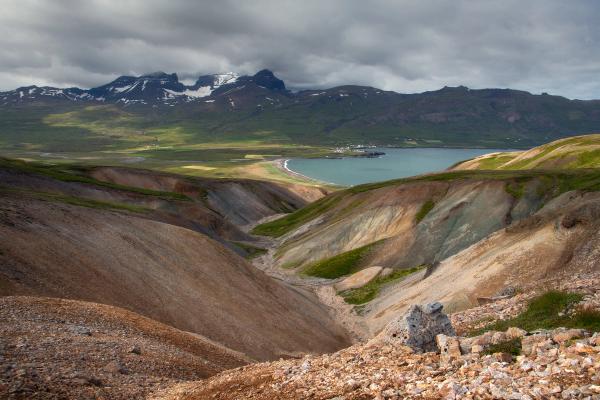
Making the Most of September in Iceland
If you're planning an Iceland trip, September hits the sweet spot – most summer activities still run but without the crowds. The first Northern Lights begin to appear, while the landscape transforms into rich autumn colors that photographers adore.

